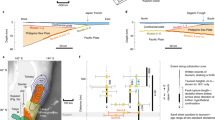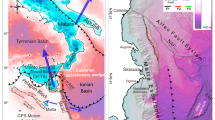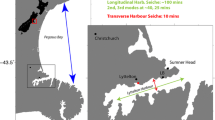Abstract
Evaluating the hazard potential of the Makran subduction zone requires understanding the previous records of the large earthquakes and tsunamis. We address this problem by searching for earthquake and tectonic proxies along the Makran Coast and linking those observations with the available constraints on historical seismicity and the tell-tale characteristics of sea floor morphology. The earthquake of Mw 8.1 of 1945 and the consequent tsunami that originated on the eastern part of the Makran are the only historically known hazardous events in this region. The seismic status of the western part of the subduction zone outside the rupture area of the 1945 earthquake remains an enigma. The near-shore shallow stratigraphy of the central part of Makran near Chabahar shows evidence of seismically induced liquefaction that we attribute to the distant effects of the 1945 earthquake. The coastal sites further westward around Jask are remarkable for the absence of liquefaction features, at least at the shallow level. Although a negative evidence, this possibly implies that the western part of Makran Coast region may not have been impacted by near-field large earthquakes in the recent past—a fact also supported by the analysis of historical data. On the other hand, the elevated marine terraces on the western Makran and their uplift rates are indicative of comparable degree of long-term tectonic activity, at least around Chabahar. The offshore data suggest occurrences of recently active submarine slumps on the eastern part of the Makran, reflective of shaking events, owing to the great 1945 earthquake. The ocean floor morphologic features on the western segment, on the contrary, are much subdued and the prograding delta lobes on the shelf edge also remain intact. The coast on the western Makran, in general, shows indications of progradation and uplift. The various lines of evidence thus suggest that although the western segment is potentially seismogenic, large earthquakes have not occurred there in the recent past, at least during the last 600 years. The recurrence period of earthquakes may range up to 1,000 years or more, an assessment based on the age of the youngest dated coastal ridge. The long elapsed time points to the fact that the western segment may have accumulated sufficient slip to produce a major earthquake.








Similar content being viewed by others
References
Ambraseys NN, Melville CP (1982) A history of Persian earthquakes. Cambridge University Press, Cambridge, p 219
Apel E, Bürgmann R, Bannerjee P, Nagarajan B (2006) Geodetically constrained Indian plate motion and implications for plate boundary deformation. EOS Trans AGU 85(52):T51B-1524
Bayer R, Chéry J, Tatar M, Vernant Ph, Abbassi M, Masson F, Nilforoushan F, Doerflinger E, Regard V, Bellier O (2006) Active deformation in Zagros–Makran transition zone inferred from GPS measurements. Geophys J Int 165:373–381. doi:10.1111/j.1365-246X.2006.02879
Bilek SL, Lay T (2002) Tsunami earthquakes possibly widespread manifestations of frictional conditional stability. Geophys Res Lett 29. doi:10.1029/2002GL015215
Bilham R, Lodi S, Hough S, Bukhary S, Murtaza Khan A, Rafeeqi SFA (2007) Seismic hazard in Karachi, Pakistan: uncertain past, uncertain future. Seismol Res Lett 78:601–613
Bilham R, Lodi S, Bendick R, Molnar P (2009) Aseismic slip on the Makran Coast? In: 2008–2012 UNAVCO proposal: geodesy advancing Earth science research, pp 3–10
Bourget J, Zaragosi S, Ellouz-Zimmermann S, Ducassou E, Prins MA, Garlan T, Lanfumey V, Schneider J-L, Rouillard P, Giraudeau J (2010) Highstand vs. lowstand turbidite system growth in the Makran active margin: imprints of high-frequency external controls on sediment delivery mechanisms to deep water systems. Mar Geol 274:187–208
Broecker WS, Bender ML (1972) Age determinations on marine strandlines. In: Bishop WW, Miller JA (eds) Calibration of hominoid evolution. Scottish Academic Press, Edinburgh, pp 19–35
Byrne DE, Sykes LR, Davis DM (1992) Great thrust earthquakes and seismic slip along the plate boundary of the Makran subduction zone. J Geophys Res 97:449–478
Chandra U (1984) Focal mechanism solutions for earthquakes in Iran. Phys Earth Planet Inter 34:9–16
DeMets C, Gordon RG, Argus DF, Stein S (1990) Current plate motions. Geophy J Int 101:425–478
Gharibreza M, Motamed A (2006) Late Quaternary paleoshorelines and sedimentary sequences in Chabahar Bay (southeast Iran). J Coast Res 22:1499–1504
Heidarzadeh M, Pirooz MD, Zaker NH, Yalciner AC, Mokhtari M, Esmaeily A (2008) Historical tsunami in the Makran subduction zone off the southern coasts of Iran and Pakistan and results of numerical modeling. Ocean Eng 35:774–786. doi:10.1016/j.oceaneng.2008.01.017
Horton BP, Gibbard PL, Milne GM, Morley RJ, Purintavaragul C, Stargardt JM (2005) Holocene sea levels and paleoenvironment, Malay-Thai Peninsula, Southeast Asia. Holocene 15:1199–1213
Jackson J, McKenzie D (1984) Active tectonics of the Alpine-Himalayan belt between Turkey and Pakistan. Geophys JR Astron Soc 77:185–264
Kanamori H (1972) Mechanism of tsunami earthquakes. Phys Earth Planet Int 6:246–259
Kopp C, Fruehn J, Flueh ER, Reichert C, Kukowski N, Biala J, Klaeschen D (2000) Structure of the Makran subduction zone from wide-angle and reflection seismic data. Tectonophysics 329:171–191
Kukowski N, Schillhorn T, Flueh ER, Huhn K (2000) Newly identified strike-slip plate boundary in the northwestern Arabian Sea. Geology 28:355–358
Kukowski N, Schillhorn T, Huhn K, von Rad U, Husen S, Flueh ER (2001) Morphotectonics and mechanics of the central Makran accretionary wedge off Pakistan. Mar Geol 173:1–19
Lambeck K (1996) Shore line reconstructions for the Persian Gulf since the last glacial maximum. Earth Planet Sci Lett 142:43–57
Masson F, Anvari M, Djamour Y, Walpersdorf A, Tavakoli F, Daignières M, Nankali H, Van Gorp S (2007) Large-scale velocity field and strain tensor in Iran inferred from GPS measurements; new insight for the present-day deformation pattern within NE Iran. Geophys J Int 170:436–440. doi:10.111/j.1365-246X.2007.03477.x
McCall GJH (2002) A summary of the geology of the Iranian Makran. In: Clift PD, Kroon D, Craig J (eds) The tectonic and climatic evolution of the Arabian Sea Region. Geol Soc Lond Spec Publ 195:147–204
Mokthari M, Fard IA, Hessami K (2008) Structural elements of the Makran region, Oman Sea and their potential relevance to tsunamigenesis. Nat Hazards 47:185–199
Murty T, Rafiq M (1991) A tentative list of tsunamis in the marginal seas of the north Indian Ocean. Nat Hazards 4:81–83
Musson RMW (2009) Subduction in the western Makran: the historian’s contribution. J Geol Soc Lond 166:387–391
Neetu S, Suresh I, Shankar R, Nagarajan B, Sharma R, Shenoi SSC, Unnikrishnan AS, Sundar D (2011) Trapped waves of the 27 November 1945 Makran tsunami: observations and numerical modeling. Nat Hazards. doi:10.1007/s11069-011-9854-0
Obermeier SF (1996) Using liquefaction-induced features for paleoseismic analysis. In: Paleoseismology McCalpin J (ed). Academic Press, New York, p 588
Pacheco JF, Sykes LR, Scholz CH (1993) Nature of seismic coupling along simple plate boundaries of the subduction typ. J Geophys Res 98:14133–14159
Page WD, Alt JN, Cluff LS, Plafker G (1979) Evidence for the recurrence of large-magnitude earthquakes along the Makran coast of Iran and Pakistan. Tectonophysics 52:533–547
Pendse CG (1948) A short note on the Makran earthquake of the 28 November 1945. J Sci Ind Res 5:106–108
Platt JP, Legget JK, Alam S (1985) Large-scale sediment underplating in the Makran accretionary prism. Southwest Pakistan. Geology 13:507–511
Prakash S, Puri VK (2010) Recent advances in liquefaction of fine grained soils. In: 5th international conference on recent advances in geotechnical earthquake engineering and soil dynamics, San Diego, California, pp 1–6
Quittmeyer RC (1979) Seismicity variations in the Makran region of Pakistan and Iran: relation to great earthquakes. Pageoph 117:1212–1228
Quittmeyer RC, Kafka AL (1984) Constraints plate motions in southern Pakistan and the northern Arabian Sea from the focal mechanisms small earthquakes. J Geophys Res 89:2444–2458
Rajendran CP, Rajendran K (2001) Characteristics of deformation and past seismicity with the 1819 Kutch earthquake, northwestern India. Bull Seism Soc Am 91:407–426
Rajendran CP, Ramanamurthy MV, Reddy NT, Rajendran K (2008) Hazard implications of the late arrival of the 1945 Makran tsunami. Curr Sci 95:1739–1743
Rani VS, Srivastav K, Srinagesh D, Dimri VP (2011) Spatial and temporal variations of b-value and fractal analysis for the Makran Region. Mar Geol 34:77–82. doi:10.1080/01490419.2011.547804
Schlüter HU, Prexl A, Gaedicke Ch, Roese H, Reichert Ch, Meyer H, von Daniels C (2002) The Makran accretionary wedge: sediment thickness and ages and the origin of mud volcanoes. Mar Geol 185:219–232
Shah-hosseini M, Morhange C, Naderi Beni A, Marriner N, Lahijani H, Hamzeh M, Sabatier F (2011) Coastal boulders as evidence for high-energy waves on the Iranian coast of Makran. Mar Geol 290:17–28
Snead RE (1967) Recent morphological changes along the coast of West Pakistan. Ann As Am Geogr 57:550–565
Sondhi VP (1947) The Makran earthquake 28th Nov. 1945. The birth of new islands. Indian Miner 4:147–158
Stuiver M, Reimer PJ (1993) Extended 14C database and revised CALIB 3.0 14C age calibration program. Radiocarbon 35:215–230
Uchupi E, Swift SA, Ross DA (2002) Morphology and late quaternary sedimentation in the Gulf of Oman Basin. Mar Geophys Res 23:185–208
Updike RG, Egan JA, Moriwaki Y, Idriss IM, Moses TL (1988) A model for earthquake-induced translatory landslides in Quaternary sediments. Geol Soc Am Bull 100:783–792
Vernant Ph, Nilforoushhan F, Hatzfeld D, Abbassi MR, Vigny C, Masson F, Nankali H, Martinod J, Ashtiani A, Bayer R, Tavakoli F, Chéry J (2004) Present-day crustal deformation and plate kinematics in the Middle East constrained by GPS measurements in Iran and Northern Oman. Geophys J Int 157:381–398
Vita-Finzi C (2002) Neotectonics on Arabian Sea coasts. In: Clift PD, Kroon D, Craig J (eds) The tectonic and climatic evolution of the Arabian Sea Region. Geol Soc Lond Spec Publ 195:87–96
White RS, Ross DA (1979) Tectonics of the western Gulf of Oman. J Geophys Res 84:3479–3489
Woodroffe SA, Horton BP (2005) Holocene sea-level changes in the Indo-Pacific. J Asian Earth Sci 25:29–43
Wyss M, Al-Homoud AS (2004) Scenarios of seismic risk in the United Arab Emirates, an approximate estimate. Nat Hazards 32:375–393
Acknowledgments
We thank the Vahid Chengini, Director, Iranian National Oceanographic Institute, Tehran, for the help and logistics to conduct fieldwork along the Makran Coast. CPR thanks the Department of Science and Technology, New Delhi, for the Ramanujan Fellowship scheme for the financial support to visit Chabahar (Iran) during November 2008. The Indian Ocean Commission, UNESCO, funded the fieldwork during October 2010. We are thankful to Jane Cunneen and Brian Atwater for all their help. We thank Eduard Reinhardt, McMaster University, for his help during our first phase of fieldwork in Chabahar, and Razyeh Lak and Ali Mohamadi of the Geological Survey of Iran and Eko Yulianto of Indonesian Institute of Sciences (Lembaga Ilmu Pengetahuan Indonesia) for their help during the second phase of fieldwork around Jask and Bandar Abbas. CPR and KR thank the Ministry of Earth Sciences, Government of India, and Indian National Centre for Ocean Information Services, Hyderabad, India, for supporting earthquake and tsunami research at the Centre for Earth Sciences at the Indian Institute of Science. The manuscript improved much from the comments of three anonymous reviewers and the editor Thomas Glade.
Author information
Authors and Affiliations
Corresponding author
Rights and permissions
About this article
Cite this article
Rajendran, C.P., Rajendran, K., Shah-hosseini, M. et al. The hazard potential of the western segment of the Makran subduction zone, northern Arabian Sea. Nat Hazards 65, 219–239 (2013). https://doi.org/10.1007/s11069-012-0355-6
Received:
Accepted:
Published:
Issue Date:
DOI: https://doi.org/10.1007/s11069-012-0355-6




